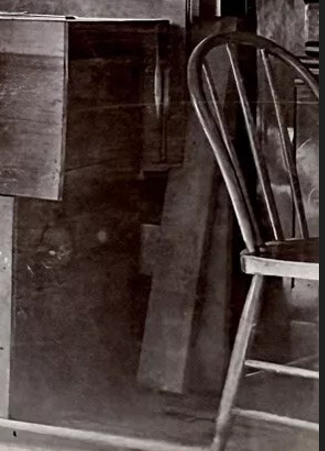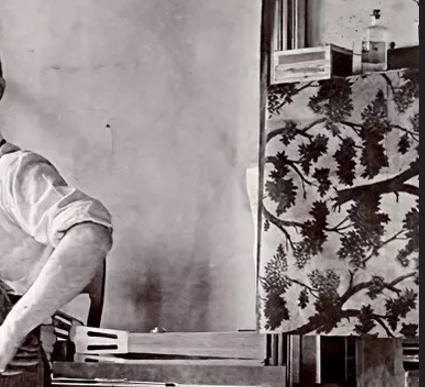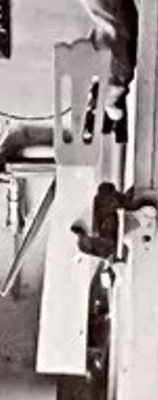Ogden Avenue
In 1890, at the 26th anniversary of Lyon & Healy's founding, a group of reporters were invited to tour the factory and report about what they had seen. This five-story factory was built on Ogden Avenue, facing Union Park, after the company outgrew their previous facility on Canal Street.
When you entered the front doors, you found managers' offices, drafting rooms where instruments and machines were designed, and a sample room containing examples of what Lyon and Healy produced. The rooms were paneled in oak and furnished with oak chairs, desks, and cabinets. As you left the offices and walked into the shipping department, one would be overwhelmed by the quantity of boxes and creates destined for stores and consumers all over North America and across the Atlantic. Even as far as Sydney, Australia.
Adjacent to the packing room was the sawing department located in the south wing of the first floor, likely the loudest room in the entire factory. Here, rough timbers from across the globe were brought to the factory and sawn, planed, and stacked to fully dry before craftsmen transformed them into instruments. One reporter made special note of the "graduating" machine which reduced the spruce, mahogany, oak, and rosewood to the uniform thickness required for instruments. The reporter doesn't mention whether the woods are sanded or scraped to thickness but does note that the bed of the machine sits on a large screw which can be adjusted to a thousandth of an inch.
 |
Two men passing wood through the "graduating" machine
(Lyon & Healy, 1896) |
Another fascinating tool is the "fretting" machine which was invented by factory superintendent George V. Durkey, who was also responsible for the Durkey patent guitar bridge. 18 razor thin saw blades were mounted to an arbor at scientifically precise measurements and a board would be passed under the arbor to slice the slots for the fretboard. This machine would've been revolutionary for its precision and repeatability and the design remained in use for decades. I spoke with Dean Zelinsky, of Dean Guitars, who had purchased a similar machine from the auction of the Kay guitar factory and had used it to launch his brand. Another tool of note was a duplicating lathe, like those used for gun stocks, that turned billets of Spanish cedar or mahogany into a shaped neck ready for a guitar or mandolin.
 |
Operating the duplicarver making guitar necks
(Lyon & Healy, 1896) |
In the west wing were the blacksmith and metalworking departments. The blacksmiths made tools, fixtures, and repairs needed to run the factory while the metalworking department created the hardware for their products. A 400lb drop hammer stamped out cymbals in "two blows" before the metal was taken to a trip hammer which pounds a spinning cymbal to work harden the metal. A lathe is used to finish the cymbal for the correct sound and appearance. Banjo pots and tambourines were also formed in this wing using lathes and specially fabricated tooling. One quality that sets Lyon and Healy apart was that they also fabricated machine heads, or tuning machines as we know them, for their instruments in this wing. Most other manufacturers relied on companies to construct their tuning machines but Lyon and Healy retained control over every aspect of what went into their instruments.
Producing a machine head began with a sheet of metal, typically brass or steel, passing through a large press which stamps out the shape and holes of each tuner plate. A screw machine cuts threads into a rod of iron and another machine cuts gears into another rod; these will become mechanism that allow the string to be brought up to pitch and remain at that pitch. After all the pieces are assembled and the buttons attached via riveting (mushrooming the end over the celluloid button), the tuner is complete and ready for the next department. It was estimated that over 870,000 parts of tuners are produced annually for their instruments.
 |
A craftsman likely scraping the sides of a glued-up guitar body
(Lyon & Healy, 1896) |
Next along the tour was the guitar department with "no less than 7,000 instruments being seen here in various stages of construction". Similarly, around 2,000 mandolins were in the process of being bent, glued, and polished as they walked through the factory. Among the other instruments, Mr. Healy pointed out to the group that they had shipped 3,000 banjos to London in the past two years owing to its popularity. The reporter mentions the harp and organ department in a few sentences with little detail. After concluding the tour of the factory, all twenty-four members of the tour group were were seated in a banquet hall as speeches and small musical performances honored the twenty-six years in business as Lyon & Healy
Chicago Daily Herald
In 1896, Lyon and Healy reprinted the description of the tour that originally appeared in the Chicago Daily Herald. This is one of the best descriptions of an 1800s guitar factory that I have ever read and will paraphrase the author's observations here. The article in it's entirety can be read here:
Google Books - Lyon and Healy "Handbook of Music and Musical Instruments"
The Lyon and Healy factory facing Union Park is five stories tall with fifteen rooms and 100,000 square feet of floor space. The building is powered by a 150 horsepower Corliss engine in addition to a 30hp engine for heating and ventilation. A tank on the roof holds 8,000 gallons of water and faucets spaced ten feet apart provide adequate coverage in the case of combustion. Within this factory, craftsmen build guitars, mandolins, zithers, banjos, banjorines, banjorettes, guitar-banjos, tamborines, drums, flageolets, harps, dulcimers, cymbals, fifes, bones, and organs. An equally staggering number of wood species are used including six varieties of maple, hickory, spruce, elm, whitewood, rosewood, mahogany, Spanish cedar, lignum vitae, ebony, and olivewood. Other raw materials include mother-of-pearl, tortoise shell, brass, zinc, copper, nickel, silver, gold, and platinum. The operations of a factory were described as a "beehive" with each craftsman working on their specialty before handing the instrument on to the next worker.
 |
Drilling the bracket holes in banjo hoops
(Lyon & Healy, 1896) |
In the wood room on the first floor, twenty different machines are found being operated by the same number of workmen. A steam powered lathe, invented by the superintendent of the factory, can transform a billet of wood into an instrument neck with a speed unheard of in the industry. Where a talented woodworker could make fourteen necks in a day, this machine can carve one hundred and sixty. The description of this tool matches that of a duplicating lathe as a pattern is placed in the machine along with a beam of wood and the cutting operation makes an exact replica. The reporter notes that it only takes about three minutes to fabricate a neck. Another man works at a lathe creating drumsticks. He inserts a cut of ebony, which strikes me as an odd choice but I am no drummer, between the headstock and tailpiece of the lathe and carves then sands a drumstick. The reporter clocked the operation at 1 minute and 8 seconds. Further down the hall is another craftsman soaking sheets of maple and hickory in boiling water before placing them in a brass mold to form a hoop. The ends are cut flush and then glued together.
 |
| (Lyon & Healy, 1896) |
The tour steps into another room with a faint chemical smell where two men work among tubs dipping and transferring metal pieces into solutions for electro plating. Here, the hardware is plated in gold, silver, and nickel as needed. A bath of sulfuric acid is used to clean the metal, water washes away the acid, then into a tub of potash which leave the metal shiny and glistening. The workers are protected by "stout rubber gloves", I can only hope the room was well ventilated. The group proceeds into the polishing room where they are greeted by spinning cotton wheels in front of men and boys who are given boxes of materials that they are to polish.
 |
| (Lyon & Healy, 1896) |
Off to the inlay room to see how the pearl gets processed to adorn the instruments of Lyon and Healy. The room contains a large closet with shelves full of glimmering shells, primarily from southern California, that retail for eight cents a pound in the rough. More expensive shells from Australia cost fourty-five cents a pound. The workers handle the shells with care as they use a power saw to cut the raw shell into squares which are then taken to a steam-powered grindstone to flatten the pearl into slabs. The reporter mentions their astonishment at seeing how much shell was tossed out or lost in order to process the blanks. From here, boys (very often apprentices in their early teens) will sit with fine-toothed saws and cut the pearl to shape and perform rough inlay work. The more experienced men handle the finer artistry by carving lines and designs into the pearl.
"A stout brass rod is feeing the yawning jaw of the machine, and it bites of chunks of it, seizes them with its teeth and claws and twists, twirls them and knocks them round and round, finally dropping the product in a basin underneath. You look at it and find it is a nut for a banjo bolt with the thread running around on the inside of it"
Passing into the machine room, no less than fourty-five machines are situated in a large workshop dedicated to metal. Many of the machines run their processes automatically but require a boy to stand within reach to swap parts and start the process.
The author notes a pleasant feeling leaving the "kingdom of rough, inartistic metal" as they pass into the woodshops. He notes a hundred or more men visible working on every stage of these instruments as they lay on benches, dry on shelves, and rest on floors. Describing a "row of funny-looking objects, with screws stretching out all over them" are the bowlback mandolins in their jigs meant to press the wood strips into shape. Bowlback mandolins are constructed from varying strips of hardwood that are steambent into a curve, glued on their edges, and form the "bowl" that is responsible for projecting sound from the instrument. An iron mold is used in this factory to keep the shape while screws hold everything in alignment for clamping. An odor of rosewood fills the room of instruments and, it is explained, that because rosewood is so gummy they iron each strip before gluing to remove as much resin as possible.
 |
A 'library' of woods left in the open for proper drying before use
(Lyon & Healy, 1896) |
In the drying rooms, Lyon and Healy airdries their lumber without artificial heat believing it to be detrimental to the structure of the wood. The room is filled with racks and each rack contains shelves with up to 2,400 pieces of wood sitting on wooden pins for adequate airflow. This is where the the backs, sides, and tops of future instruments are stored until they have seasoned for at least five years. Next to the drying room is a gluing room where the bent sides of an instrument are glued to the top and back by large presses suspended from the ceiling. Each piece is coated with hot hide glue and, in my observation, scraped with a "toothing" blade to promote adhesion, and then placed into a press where the author notes that they remain for one and a half hours.
 |
A worker clamping braces onto the top or back of a guitar
(Lyon & Healy, 1896) |
The job of slotting fingerboards is made easier by the invention of a machine that allows for a board to be affixed, a crank is turned, and precisely located saws cut the slots to an equal depth at a mathematically determined spacing. Another worker sits in front of a lathe spinning ivory and ebony to fashion buttons and keys. And without much fanfare, the article ends.
Fullerton Avenue Factory
 |
| Image Credit: [3] |
In 1914, Lyon and Healy constructed a new piano factory at 4100 Fullerton Avenue in Chicago at a cost of $450,000. [2][3]. The structure was laid out in a shape similar to a capital "E" with each wing being 60 feet wide. The building was constructed with reinforced concrete, large windows, red brick, and a white terracotta trim to blend function with beauty. Much like the factory on Ogden, the first floor was dedicated to processing the lumber using the newest electric saws, planers, and sanding machines [2]. The most interesting detail of the factory was the attention paid to incorporating natural light through use of large windows spaced frequently around the structure.
 |
| Image Credit: [3] |
The "Daylight Factory", as it was known, was designed to capture light no matter the time of day with at least 50% of the wall space being window. The interior pillars were painted white, to reflect light, and skylights allowed for even more illumination on the top floor. R. H. Waud, the plant's superintendent believed that this attention to the needs of their workers was reflected in the work that they produced. I found it humorous that Mr. Waud noted his plant also suffered the "characteristic post-war tendency" of workers to "pick up their hats and leave if urged ever so politely and gently to speed up". To expedite construction, all of the operations were laid out to keep everything moving in a line with as little backtracking as possible. Once a craftsman finished a component, it left for the next department [3].
 |
| Image Credit: [3] |
The raw lumber enter the campus on a spur track from the Chicago, Milwaukee, and St Pail railway and are loaded on trucks which haul them to the kilns for drying. The wood is then easily moved to the first floor where craftsmen use electric saws, planers, and sanders to process the timber. Still on the first floor, the dimensioned lumber moves to the the cabinetmaking room where veneers are glued, lumber is shaped into components, and the carcass of the piano constructed. An elevator on the southern end lifts the soon-to-be pianos to the second floor where the staining and grain filling can be taken care of. Here the benches are assembled and the pianos are fully assembled and tested. The pianos take another ride to the fourth floor "rubbing rooms" where they are finished and polished before being sent back down to the second floor to be prepared for shipping. The north end of the second floor opens onto an elevated track where the finished instruments can be loaded directly onto the train cars and shipped to their their distributors. The third floor contains the machinist shop and also doubles as a room for construction of harps, banjos, mandolins, and violins [3].
Interestingly, the equipment seen on each floor was listed.
First Floor
- Back shaper
- Automatic drill
- Sanding Machine
- Two belt sanders
- Scraper
- Trim Saw
- Band Saw
- Two Rip Saws
- Grinder and emery wheel
- Veneer splicing machine
- Veneer cutter
- Veneer hydraulic press
- Veneer gluing machine
- Sawdust blower
- Three jointers
- Rip saw
- Glue Press
- Swing saw
- Two planers
- One sticker(?)
- Automatic turning lathe
- Boring machine
On the third floor in the harp department:
- Lathes
- Drill presses
- Punch presses
- Etc
In the machine shop
- Jig saw
- Drill press
- Table Saw
- Grind Stone
On the fourth floor
- Rubbing machines
- Band saw
- Drill press
- Emery wheel
Sources
[1] hMusical Courier Company. Musical Courier: A Weekly Journal Devoted to Music and the Music Trades, Volumes 20-21 https://books.google.com/books?id=hG-BPEXqX-MC&pg=RA2-PA414&dq=lyon+and+healy+factory+tour&hl=en&newbks=1&newbks_redir=0&sa=X&ved=2ahUKEwjv1_DuutOEAxU5OTQIHdY-D90Q6AF6BAgHEAI
[2] Violinist Publishing Company. The Violinist. 1915 https://books.google.com/books?id=i6pGAQAAMAAJ&pg=RA5-PA29&dq=lyon+and+healy+factory&hl=en&newbks=1&newbks_redir=0&sa=X&ved=2ahUKEwjYleLXu9OEAxULFzQIHatSA3oQ6AF6BAgMEAI
[3] Hardwood Company. Hardwood Record, Volume 49. 1920 https://books.google.com/books?id=kgI3AQAAMAAJ&pg=RA3-PA27&dq=lyon+and+healy+factory&hl=en&newbks=1&newbks_redir=0&sa=X&ved=2ahUKEwjYleLXu9OEAxULFzQIHatSA3oQ6AF6BAgIEAI



























































Follow Us
I'm a college student who is fascinated with guitars and collecting and repairing them